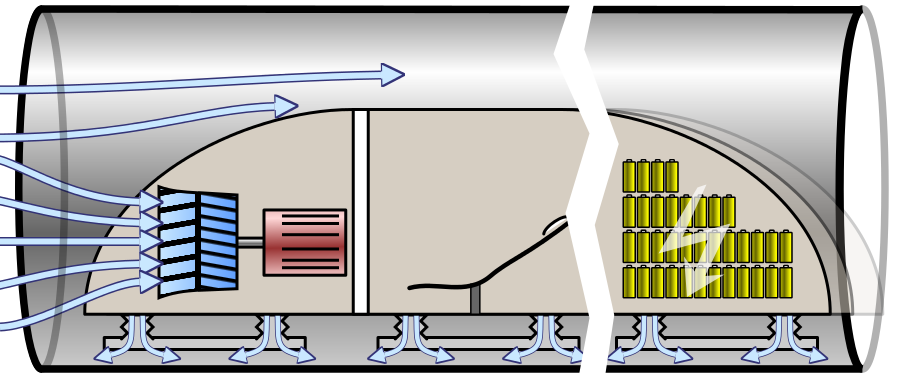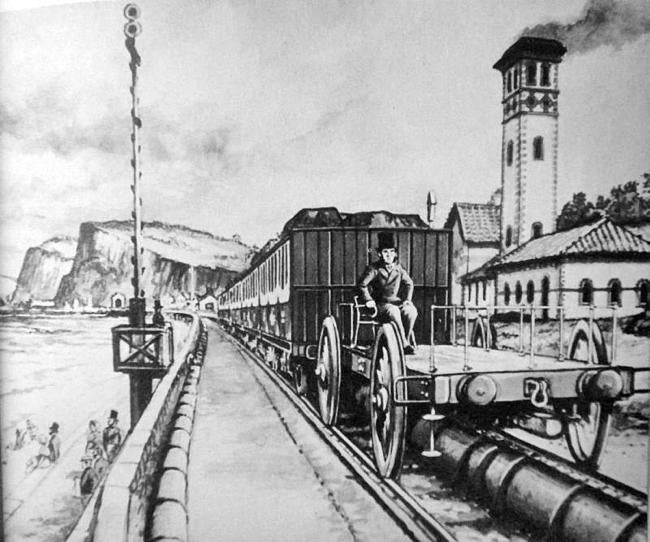Have you heard of "hyperloop"? According to Wikipedia, it's a "a new mode of passenger and freight transportation that propels a pod-like vehicle through a near-vacuum tube." Imagine a subway but over longer distances between major cities, and much faster, comparable to airplanes and beyond, I suppose, mag-lev trains. Several companies are exploring the feasibility of the new technology, although to my knowledge nothing exists in any practical form at the moment.
Famously, the concept has attracted the attention of electric-car-maker, space-rocketeer, and techno-champion, Elon Musk. He has promoted the idea, and even sponsored the Hyperloop Pod Competition, which is hoped will expand the enthusiasm and frontiers of hyperloop knowledge. There's even a local connection: the Waterloop, a student-designed pod from UW designed to compete in the contest. At least one student in a course I taught recently is involved.
Somewhat coincidentally, as I was learning about the Waterloop, I happened across a related article: "The Atmospheric Railway of I.K. Brunel", by R. A. Buchanan. Atmospheric railways are, of course, a direct ancestor of the hyperloop, which is not so new after all! They are both an atmospheric, or "pneumatic device depending on the pressure difference in a tube from which the air had been partially evacuated to propel a piston or capsule along the tube." (p. 232) Although most of us are familiar, via the movies, with smaller-scale systems designed for mail sorting and delivery in the early to mid 20th century, what fewer know about were attempts in the 19th century to build larger-scale systems that were comparable to the relatively new railway systems.
In particular, the technology was promoted by Isambard Brunel, a relatively young but already quite famous engineer with an "outstanding" public reputation for ship-building, bridge-building and similar contributions to technology and society. That's him on train in the photo above. In the 1840s, Brunel designed and oversaw the development and construction of an atmospheric railway along part of the South Devon Railway line. As you can see, it was designed to use an atmospheric tube to draw the regular train cars along a track, replacing a sooty, dirty steam locomotive. Desite a great deal of enthusiasm, the project and others like it failed within a few years, thanks to "overwhelming problems of operation and maintenance", especially when compared to the "constant improvements in the efficiency of steam locomotives" (p. 232)
What struck me as I read Buchanan's conclusions were the potential parallels to the hyperloop. As he asks, given the lack of experience or any previous success with atmospheric railways in the mid 19th century, why did anyone sponsor rapid and expensive commercial development in the first place? Buchanan's view is that in the 1840s engineers were surrounded by "an abundance" of new, untested but really attractive ideas, and many seemed to work well, such as electric telegraphs. To me, this sounds a bit like recent transportation experiments in self-driving or autonomous cars, all-electric cars, car-sharing (ie: Uber), and the return of light rail.
Surrounded by so many new ideas, "visionary" engineers like Brunel were easily "tempted by the advantages the atmospheric system appeared to offer–light trains, speed, freedom from smoke"–similar to the hyperloop, which people like Musk hope will be "energy-efficient, quiet and autonomous".
But nobody in the 1840s could have foreseen the continuing evolution and success of steam locomotives. Brunel, though a skilled engineer with many successes behind him, was not really a railway engineer and likely missed many locomotive and track developments. His competitors, such as the Stephensons, had much more direct experience in the field and succeeded with what we might see today as a more linear, evolutionary development of railways.
Musk's own successes have been remarkable, even disruptive: Tesla is rewriting the rules of the automotive market and electric battery manufacturing, and SpaceX–which is the direct sponsor of the HyperLoop Pod Competition–was the first private company to carry out commericial rocket launches, sending payloads into orbit or the International Space Station. Will this translate into hyperloop success? (Note: Musk doesn't appear to have any direct involvement in any company actually developing hyperloop pods or tubes, but he is a figurehead and promoter.)
Brunel's reputation managed to survive the collapse of the Atmospheric Railway. Will Musk be remembered for the Hyperloop? Time will tell.

